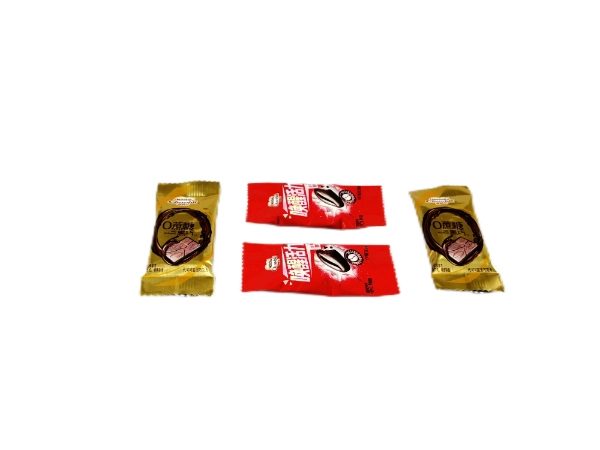In the competitive confectionery industry, packaging plays a critical role not only in product protection but also in brand identity and customer engagement. Among these, chocolate wrapper printing paper holds particular significance. In this blog post, Leater, as a professional flexible packaging for food product factory, will share the design and manufacturing process of custom chocolate wrapper printing paper for sale.
Understanding the Role of Chocolate Wrappers
Chocolate wrappers serve multiple functions: they preserve product freshness, protect against moisture and contaminants, convey brand information, and create visual appeal. For custom chocolate wrapper paper, these responsibilities are magnified, requiring a tailored balance between aesthetics and functionality.
Key Considerations in Chocolate Wrapper Printing Paper Design
1. Brand Identity and Visual Appeal
The design of a chocolate wrapper is often the first impression a customer gets. Custom printing allows brands to communicate their identity through color schemes, typography, logos, and thematic graphics. Seasonal designs or limited-edition variants can also be achieved with flexible print runs.
2. Consumer Psychology
Colors and textures influence perception. For instance, metallic finishes suggest luxury, while kraft paper evokes naturalness and sustainability. Design elements should align with target market preferences and evoke desired emotional responses.
3. Legal and Informational Compliance
The wrapper must include essential product details like ingredients, nutritional information, expiry date, manufacturer data, and any required certifications (e.g., FDA, ISO, HACCP). These must be clearly visible and resistant to smudging.

Material Selection for Chocolate Wrapper Printing Paper
Choosing the right material is crucial for protecting chocolate' s integrity while allowing high-quality print output. Typical base materials include:
1. Aluminum Foil Laminated Paper
Widely used due to its excellent barrier properties against moisture, light, and oxygen. The foil is often laminated with paper for added strength and printability.
2. Wax-Coated or Greaseproof Paper
These papers offer resistance to grease and provide a tactile finish. They are often used for artisanal or environmentally focused brands.
3. Biodegradable and Recyclable Options
With rising environmental awareness, materials like PLA-coated paper, recyclable kraft paper, and compostable films are gaining popularity. They require specific printing techniques to maintain performance.
Printing Technologies for Custom Wrappers
The choice of printing method significantly affects color quality, registration precision, and cost-effectiveness. Common technologies include:
1. Flexographic Printing
Ideal for large-volume runs, flexo printing uses fast-drying inks and flexible plates. It provides good consistency and is cost-effective for long-term branding.
2. Gravure Printing
Preferred for premium-quality results, gravure printing offers high resolution and excellent color density. It' s suitable for metallic finishes and detailed photographic effects.
3. Digital Printing
Best for short runs or customized designs, digital printing allows for variable data (e.g., QR codes, personalization) and fast turnaround times. It' s suitable for start-ups or limited editions.
4. Hot Foil Stamping and Embossing
These finishing techniques enhance visual and tactile appeal. Foil stamping adds reflective effects, while embossing provides raised text or patterns for a luxurious feel.
Ink and Coating Selection
Inks used for chocolate wrapper paper must be food-safe, odorless, and resistant to friction and heat. Key types include:
* Water-based inks: Eco-friendly and suitable for most paper-based applications.
* UV-cured inks: Fast-drying, vibrant, and durable, often used in digital and flexo processes.
* Solvent-based inks: Provide good adhesion on laminated and non-porous surfaces, but must comply with food contact regulations.
Coatings such as overprint varnish (OPV) or lamination improve surface durability and aesthetic quality. They also prevent ink smudging during wrapping and transportation.
Chocolate Wrapper Printing Paper Manufacturing Process
The production of custom chocolate wrapper printing paper involves several synchronized stages:
1. Design Preparation
Graphics and text are prepared using specialized software, ensuring color accuracy and resolution compatibility. A dieline is created to align with the chocolate product' s dimensions.
2. Material Sourcing and Inspection
Rolls of wrapper paper or laminated foil are sourced based on client specifications. Incoming material undergoes quality checks for thickness, tensile strength, and surface consistency.
3. Printing and Drying
Using selected printing methods, the design is transferred onto the substrate. Inline drying systems (UV or hot air) cure the ink to ensure smear resistance.
4. Finishing Processes
Optional enhancements like foil stamping, die-cutting, or lamination are applied. Sheets are then cut, folded, or rolled depending on the packaging line's requirements.
5. Quality Control and Packaging
Finished wrappers are inspected for print defects, color variance, and dimensional accuracy. Accepted batches are packed and labeled for delivery.
Conclusion
The design and manufacture of custom chocolate wrapper printing paper is a multifaceted process involving aesthetic judgment, technical precision, and material science. It bridges the gap between functionality and branding, playing a critical role in consumer perception and product preservation. As sustainability, customization, and automation shape the future of packaging, chocolate wrapper printing continues to evolve, offering new opportunities for innovation and market differentiation.
www.leaterpack.com
Leater

